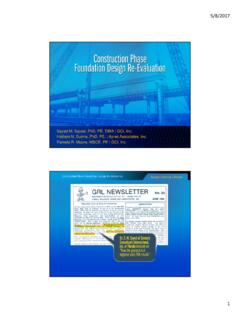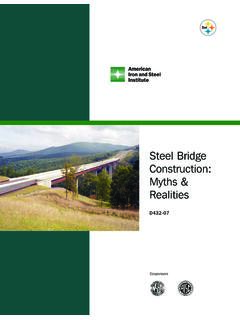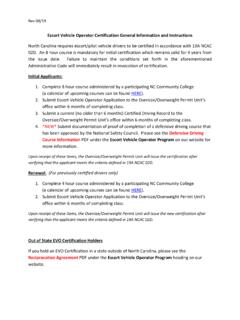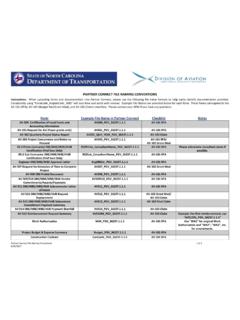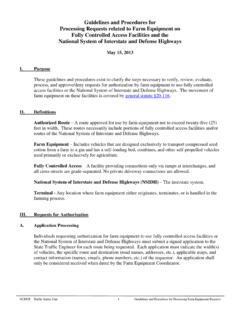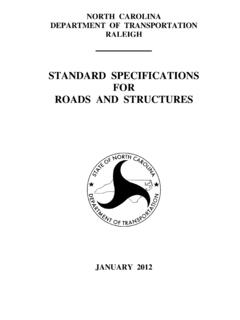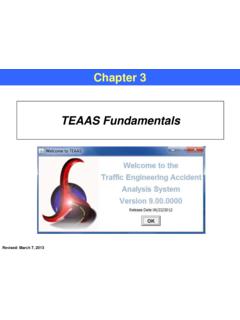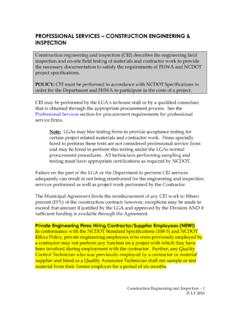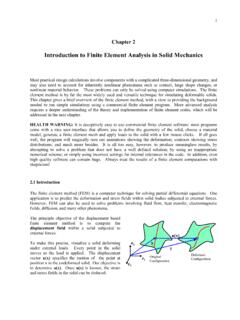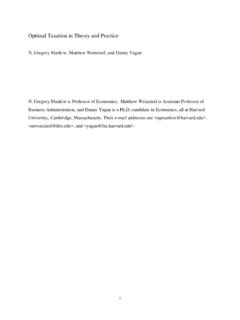Transcription of Analyses of Lateral Loaded Piles with P-Y Curves ...
1 Analyses of Lateral Loaded Piles with P-Y Curves - Observations on the Effect of Pile Flexural Stiffness and Cyclic Loading NCDOT 7th Geo3 T2, Raleigh, NC, Thursday, April 04, 2013 Session 3B - Geotechnical II (Room: Pinehurst) - Paper: 3B-1_A49 Miguel A. Pando, , P. Eng. Associate Professor, UNC Charlotte Outline Background Beam on Elastic Foundation (BEF) Subgrade Reaction Beam Theory (related to net soil reaction per unit length (P) and pile Lateral deflection (Y) P-Y Curves Elements of a P-Y curve (preferred terminology) Commonly used P-Y Curves (empirical basis) The analytical methodology Possible limitations/challenges Influence of pile cross section and EI? Effects of Lateral load cycles? Summary and Conclusions BACKGROUND Beam on Elastic Foundation (BEF) After Winkler (1867) aka as Beam on Winkler Foundation (BWF) kh = Modulus of Lateral (Horizontal) Subgrade Reaction [F/L3] Typically linear representation of soil reaction.)
2 VERTICAL HORIZONTAL Vertical Modulus of Subgrade Reaction Modulus of subgrade reaction (k) Is it a soil property? NO Footing, rafts, pavement design Westergaard s work in 1920 s q = k D (used by structural engineers) q = applied or contact pressure [F/L2] D = settlement of footing under q [L] k = q/D = slope (linear spring constant) = modulus of subgrade reaction [F/L3] q (F/L2) B Zinf Es q (F/L2) D (L) 1 k 1 ksec Elastic settlement of circular footing: = ..(1 2) m = (undrained) ~ (drained) Es = Eu (undrained) vs E (drained) = = ..(1 2) Not a fundamental soil property Not readily measured Depends on many factors such as size and shape of footing, type of soil, relative stiffness of footing and soil, vary along footing, vary with time, etc. Vertical Modulus of Subgrade Reaction (Continued) Beam theory Table 1 Relationships commonly used for elastic Piles in flexion Variable Formula Units Distance along the length of the pile (measured from pile head) x [L] Distance to neutral axis within pile cross section z [L] Deflection y [L] Slope or rotation of pile section dydx [Dimensionless] Curvature 22dydx [Radians/L] Bending moment 2p pp p2dyM E IE Idx [F x L] Shear force 3pp3dyVE Idx [F] Axial load Q [F] Soil reaction (or load intensity) 4pp4dyp E Idx [F/L] Notes.
3 EpIp = flexural stiffness of pile, where Ep = elastic modulus of pile material, and Ip = moment of inertia of pile cross section with respect to the neutral axis Relationships between variables Figure Laterally Loaded pile problem p M + dM V + dV V M dx xxxxxypy MFxdxprightp (soil resistance)plefta) Pile loadingb) Net soil reactionc) Pile deflectiond) Slopee) Bending momentxxxxxypy MFxdxprightp (soil resistance)plefta) Pile loadingb) Net soil reactionc) Pile deflectiond) Slopee) Bending momentThe Genesis of the P-Y Curve: (Reese and Van Impe, 2001) B P-y curve Method P-Y Curves p-y model used for analysis of laterally Loaded Piles Figure 2 Schematic showing p-y model used for analysis of laterally Loaded Piles x1 x2 xn xn-1 Lateral load Nonlinear springs Soil-pile reaction, p (F/L) Pile deflection,y (L) Increasing depth, x p-y Curves x Pile Careful with confusing terminology: Horizontal modulus of subgrade reaction (kh): relates Lateral pressure qh = kh x y [units: F/L3] Subgrade reaction modulus (K): p = K x y [units: F/L2] K = kh x B Coefficient of subgrade reaction (nh): rate of increase of subgrade reaction modulus (K) with depth (z): K = nh x z [units.]
4 F/L3] Soil reaction (p-y curve) and Horizontal Modulus of Subgrade Reaction (kh) Careful units of kh same as kv (F/L3) but genesis is different Net soil reaction per unit length of pile (F/L) Type equation here. qh = kh . y 1 1 (kh B) (kh _ sec B) Units: qh = [F/L2] y = [L] kh = [F/L3] qh = p/B p = (kh x B) . y Elements of a p-y curve Figure 3 Typical p-y curve and resulting p-y modulus (p,y) Epy Epy-max p = Epy . y pult Pile deflection, y (L) Soil reaction, p (F/L) Pile deflection, y (L) p-y modulus, Epy (F/L2) Epy-max Epy-max Epy-max Elements of a p-y curve Figure 3 Typical p-y curve and resulting p-y modulus (p,y) Epy Epy-max p = Epy . y pult Pile deflection, y (L) Soil reaction, p (F/L) Pile deflection, y (L) p-y modulus, Epy (F/L2) Epy-max slope Epy-max: Considerable scatter of reported values. Most Epy-max = kh x B Some P-Y Curves have Epy-max (asymptotic value): From ultimate load theories ( , Broms, 1964): Clays: 9 SuB; Sands: 3 Kps vB or Kp2s vB curve(s) from origin to Pult.
5 Epy-max Example p-y Curves in Sands (Reese et al. 1974) Pult = f( , stress level) Epy-max: related to soil stiffness, B, etc, Figure 5 Elements of a characteristic p-y curve for sand based on recommendations by Reese et al. (1974) p (F/L) y (L) b/60 3b/80 C B A Epy-max 1 [Note: b = pile width] pult P-Y Curves for Different Soil Types Stiff Clay Sand Soil w/ Sand Soft Clay Lateral deflection Soil reaction Lateral deflection Soil reaction Experimental P-Y Curves Lateral load tests on instrumented Piles Vey few high quality tests are available Basis for P-Y Curves proposed in the literature Typically from deflected shape measurements ( , inclinometers) Better if from Moment (or curvature) measurements using closely spaced pairs of strain gages (very few of these) Additional Instrumentation Front , mmDepth From Top of Pile, kNAverage Load per PileP-Y Curves from Experiments P-Y Curves from Experiments.
6 = 2 2 Commonly used p-y Curves for different soils Soil Type and Condition Reference Soft clay below the water table Matlock (1970) Stiff clay below the water table Reese, Cox, and Koop (1975) Stiff clay above the water table Welch and Reese (1972), Reese and Welch (1972) Sands Reese, Cox, and Koop (1974) Sands API RP2A (1991) Soils with cohesion and friction Evans and Duncan (1982) Weak rock Reese (1997) Strong rock Nyman (1982) (adapted from Reese and Isenhower, 1997) ANALYTICAL METHODOLOGY Software for p-y based analysis: Solve beam equation with finite difference or finite elements COM624 LPILE FB-Pier (FB-Multipier) Matlab or Mathcad spreadsheets Other Methodologies Strain Wedge Model FEM Characteristic Load Method (LPILE based) POSSIBLE LIMITATIONS OR CHALLENGES Potential Limitations P-Y Curves The soil is idealized as a series of independent nonlinear springs represented by p-y Curves .
7 Therefore, the continuous nature of the soil is not explicitly modeled. Potential Limitations P-Y Curves The results are very sensitive to the p-y Curves used. The selection of adequate p-y Curves is the most crucial problem when using this methodology to analyze laterally Loaded Piles (Reese and Van Impe 2001). P-Y Curves in literature are empirical in nature. Need to carefully review applicability of the selected Curves . On selection of appropriate p-y modulus and p-y Curves Important and difficult task. Selection of values of initial p-y modulus, Epy-max, although related to the soil modulus, is also related to the interaction between the pile and the soil. Reese and Van Impe (2001) point out that p-y Curves and modulus are influenced by several pile related factors, such as: Pile type and flexural stiffness, Type of loading (monotonic or cyclic), Pile geometry, Pile cap conditions, and Pile installation conditions.
8 Potential Limitations (Continued) Cross section of pile Most P-Y Curves only depend on pile width (B). Shape or Depth is not explicitly included in P-Y Curves currently in the literature. B B B p1 p2 p3 p2 > p1 > p3 Potential Limitations (Continued) Flexural Stiffness (EI) of pile P-Y Curves don t directly incorporated effects of EI of pile (Only in pile model). Lateral deflection Soil reaction Ashour and Norris (2000) The traditional p-y curve (in LPILE) does not account for the pile/shaft EI variation Based on the Strain Wedge Model Analysis Stiff Pile Flexible Pilep-y Curve at a Depth of mDense SandLoose SandEffect of Pile Bending Stiffness on the p-y Curve in Sand 04080120 Pile Deflection, y, mm0100200300400 Soil-Pile Reaction, p, kN / mEI EI Depth Soil Reaction, p (kN/m) Lateral Deflection, y (m) Lateral Deflection EI Effects p=120 kN/m p=170 kN/m Route 351 Bridge Case History Route 351 Bridge Case History Route 351 Bridge Case History Route 351 Bridge Case History Lateral Cyclic loading on Piles Limited experimental data.
9 API P-Y Curves for sands suggest incorporating 10% degradation of p-y curve for offshore Piles . A few experimental studies developed cyclic P-Y Curves Effect of Cyclic Loading Single Pile Test020406080100120140160020406080100 Deflection (mm)Load (kN)1st Cycle Peaks15th Cycle PeaksCyclic P-Y Curves by Little and Briaud (1988): Most experiments up to 20 Lateral load cycles. = 1. Cyclic P-Y Curves by Long and Vanneste (1994): 34 experiments (some up to 500 Lateral load cycles). Modified Pn and Yn as follows: = 1. = 1. Possible limitation with cyclic loading Little experience and scarce availability of experimental data. Available experiments very few load cycles. Wind action on highway signs, sound barrier foundations; Or loading on bridge Piles (thermal, current, wave, etc) can involve N > 104 load cycles during pile design life.
10 Experiments on Model Pile by Peng et al (2006) (N=104 cycles) (Experiment) Summary & Conclusions The P-Y Curve based methodology for analysis of laterally Loaded Piles is easy and reliable Empirical in nature, but backed by decades of experience. However, several items may still need additional research to overcome some identified possible limitations. ( , still room for improvement). Also practitioners should be aware of alternative emerging methodologies such as the SWM (Need to incorporate into design tool box) (Several DoT s already using). THANK YOU! Contact information: Dr. Miguel A. Pando Associate Professor CEE Dept, UNC Charlotte
